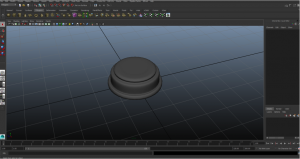BLACKSBURG, Va., March 20, 2015 – AddHawk is a group of Computer Science students taking their Human-Computer Interaction capstone project to a massive scale. They begun working on an application called PixelPusher, a massive crowdsourced display in Lane Stadium, using all the attendees mobile device screens as pixels.
Updates on PixelPusher:
 This week the AddHawk team began the development of the Android and web platforms of PixelPusher. These two platforms are the team’s first steps toward a high-fidelity prototype, which should be finalized within the next week. To give the high-fidelity prototypes the functionality that they require, an API was developed to allow for communication of data between the server and the client-facing applications. The aesthetics of the prototype are of great importance as well, so the team also spent time designing a batch of icons for the front-end of the application on both platforms.
This week the AddHawk team began the development of the Android and web platforms of PixelPusher. These two platforms are the team’s first steps toward a high-fidelity prototype, which should be finalized within the next week. To give the high-fidelity prototypes the functionality that they require, an API was developed to allow for communication of data between the server and the client-facing applications. The aesthetics of the prototype are of great importance as well, so the team also spent time designing a batch of icons for the front-end of the application on both platforms.
In addition to focusing on more front-end facing features of the high-fidelity prototype, the team debugged and worked out kinks that were causing issues on the server side of the system. At this point the system is able to serve requests at blazing fast speeds, which imbues the hearts of the AddHawks with optimism and joy.
“We’re super excited about how fast the requests are able to be processed on the backend of our system! The Phalcon PHP Framework is light as a feather and we’ve been seeing speeds that are up to seven times faster than a Ruby On Rails based API. We hope that since it’s this fast at the moment that it will scale well when we begin moving on to evaluation of the system with real people,” said PixelPusher developer Christopher Wood excitedly.
A Look Into the Future:
In the upcoming weeks the team will finish production of the high-fidelity prototype for both the web and mobile platforms. This finalization of the prototype involves connection of the front and back ends of the PixelPusher system in order to be able to present relevant tasks and functionality that the system should be able to accomplish.
Once the prototype is ready, the team will move on to begin evaluation of the system. This evaluation will test users on various metrics that the team considers valuable for the continuation and improvement of the system as a whole. Testing will initially be performed by the PixelPusher developers themselves with a small sample size of around four people. From there on, the team will move on to testing first-time and returning users with increased sample sizes.
Mission Statement:
PixelPusher will allow football fans in Lane Stadium at Virginia Tech to display individual pixels on their phones which are part of a larger image. In this way PixelPusher acts as a crowd-sourced collaboration application that will bring together football fans everywhere. PixelPusher also aims to break the current world record of 400 connected devices. The application will be developed with the idea of simplicity and efficiency at heart, providing a lightweight, seamless user interface to football fans at Virginia Tech.
“AddHawk is an up and coming software development initiative aimed at revolutionizing how a single member of a crowd can have a huge impact on an event. ”
For more information or questions please contact: cmw2379@vt.edu
